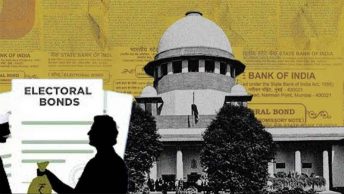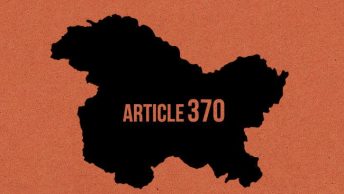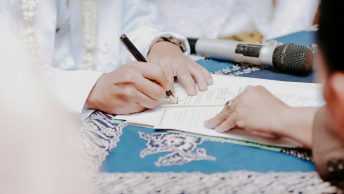With the aim of enabling our readers to keep up with the Supreme Court of India’s day-to-day hearings for the significant case concerning the abrogation of Article 370, LAOT, in collaboration with the Centre for Constitutional Law, NALSAR is bringing you a concise daily summary of what was argued in the Court. This is the summary of Day-4 proceedings and follows in the argumentative continuum surrounding the debated impermanence of Article 370, covering, among other things, thoughts from the perspective of the reactions and activism of the main legislative body, the Constituent Assembly, at the time.
Note: The arguments today proceeded on the finer points of interpreting Article 370 of the Indian Constitution, mainly around the consequences of Article 356, the harmonious existence of the two constitutions, the illegality of Constitutional Orders 272 and 273, J&K’s special place, and the meaning of accession without merger.
A Harmonious Existence
When the Bench was convened today, Sr. Adv. Mr. Gopal Subramanium explained the multiple approaches to interpreting constitutional law. The approaches can be historical, textual, doctrinal argument, and structural. He then said the outcome would be the same whichever method is followed.
Mr. Subramanium then went on to explain the harmonious relationship between the two constitutions- the Constitution of India and the Constitution of J&K. He said that the two Constitutions co-exist and speak to each other. Their complementary existence is the quintessence of the relationship between India and J&K. Amending power, he says, is a derived power as it is the constituent assembly vested with the task of framing a constitution. In the case beforehand are two constituent assemblies. Constitutional Orders 272 and 273 basically do away with the Constitution of J&K, which is not authorized. He then refers to the expression “people” with a legal, juridical existence in the constitutional context. He reminded the Court of the remarks made by CJI the previous day about finding expression through constitutional institutions in a representative democracy. He argued that such institutions are the constituent assembly and the state legislative assembly.
The Basic Structure Test and the Degree of Abrogation
Sr. Adv. Gopal Subramanium pointed out that basic structure if discerned, will be deduced from both the Indian Constitution and the Jammu and Kashmir Constitution. He referred to Glanrock Estate (P) Ltd v The State of Tamil Nadu (2010) and noted that when constitutional law is under challenge, the “effect test” ought to be applied to find out the degree of abrogation. Thus, in this case, both the degree and the effect of the action need to be seen. Subramanium refers to asymmetric federalism and the special needs of states and the people. In his introductory speech to the Constituent Assembly, Dr. Ambedkar spoke about the Indian Constitution being federal with a focus on special rights and privileges of the people of states.
An excerpt from Glanrock Estate (P) Ltd v The State of Tamil Nadu
“If one finds that the constitutional amendment seeks to abrogate core values/ over-arching principles like secularism, egalitarian equality, etc. and which would warrant re-writing of the Constitution then such constitutional law would certainly violate the basic structure.”
Why J&K is “special”
Subramanium explained why J&K was ‘special’ at the time of accession. One reason is that it had its own constitution before accession. He later mentioned the 1939 Constitution. The Constituent Assembly of India thought it appropriate to ascertain the people’s will and maintain democracy thus. He went to the J&K Constituent Assembly Debates and says it was inspiring as it was based on Rousseau’s model of representative democracy.
AUTHOR’S NOTE:
However, the author of this piece questions this reasoning as it does not give us an exact picture of the situation of Jammu and Kashmir when the Assembly was constituted. Fozia Lone, Associate Professor at the City University of Hong Kong, argues in her book ‘Historical Title, Self-Determination, and the Kashmir Question’ that the constitution of the Assembly itself started the conditions of ‘anarchy’ in J&K as all 71 members of the National Conference (NC) were declared to have been ‘elected unopposed.’ In Kashmir’s first election after accession, which took place in September–October 1951, the nomination papers of other candidates (apart from NC) were rejected. (Readers may refer to Page 252 of the abovementioned book).
Haley Duschinski and Mona Bhan have noted the UN Security Council’s position on forming the J&K Constituent Assembly in ‘The Routledge Handbook of Critical Kashmir Studies.’ The UN Resolution 91 (1951), for example, states that convening a constituent assembly to determine the future shape and affiliations of the state of Jammu and Kashmir would violate the fundamental principles outlined in Security Council Resolutions 49, 51, and 80 and UNCIP Resolutions from 1948 and 1949 which talk about a UN-monitored plebiscite. (Readers may refer to Page 330 of the abovementioned book).
Similarly, constitutional lawyer A.G. Noorani, in his ‘Article 370: A Constitutional History of Jammu and Kashmir’ argues that the formation of the J&K constituent assembly was India’s attempt to legalize Kashmir’s provisional and contested accession to India through a rigged constituent assembly election.
Therefore, it is doubtful whether the declaration of J&K as an ‘integral part’ by the Constituent Assembly of J&K has any legal-constitutional basis.
Subramanium talked about the arrangement of federalism between J&K and India, with Article 370 defining the contours of this relationship. He argues that constituent assembly and legislative assembly being different bodies cannot mean that one should take the place of another. When CJI asked if Article 356 was a fetter on the exercise of power under the second proviso of Art 370(1)(d), Subramanium said this implied fetter was expressed in the language of Article 370. Gopal Subramanium made an interesting statement when he says that Article 370 is not an instance of conditional legislation but an application of a provision of the constitution, which is a constitutive act.
Can the President not issue an Ordinance when Article 356 is in operation, asks CJI
To this question by the CJI, Subramanium said that Article 370 imposed limitations on the exercise of this power. These express limitations cannot be avoided by taking recourse to Article 370. The provision comes with a duty: the duty to act by Article 370. The purposes of these two provisions are not coincidental. He explained how different judgments postulate the continued existence of Article 370. He mentions Sampat Prakash as insisting on the continuance of Article 370. The power to amend a constitution can only lie with the body that created it.
“I’ll shake hands with you but not embrace you” – The Question of Merger
After Gopal Subramanium concluded his arguments, Sr. Adv. Zaffar Shah began his. He made an interesting argument on the question of merger. The Dogra Maharaja signed the Instrument of Accession (“IoA”) but did not sign the merger agreement. The Government of India and the Dogra king were authorities in their respective realms. The king accedes but retains all the powers except those over defence, communication, and foreign affairs. Sovereignty, in other words, the power to make laws, was retained by the Maharaja in essence. With the arrival of democracy, the monarchy was no longer appropriate. He then turned to the right of the state itself. When Article 370 subsumed the sovereignty of the Maharaja, the finality of the state could not be determined.
CJI retorted with the query that IoA talks about unconditional accession to India, as sovereignty was transferred to India except for the power of legislation. Shah replies that the IoA, being an act of state, was a compact between two sovereigns, which was like a handshake without an embrace. The Maharaja, as was his title, did not merge with India and wanted to run his own state.
“What does the constitution of India do with a state that hasn’t merged but acceded?” Zaffar Shah asked as the matter concluded for the day.
Aurif Muzafar is a doctoral fellow at NALSAR. He is also a Research Associate for the MK Nambyar SAARC Law Center, NALSAR.
[Ed Note: This piece is part of our series covering the hearing on the abrogation of Article 370. This post has been edited by Utkarsh Mani Tripathi and posted by Avani Vijay from our Student Editorial Team]







